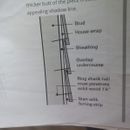Manufacturers instructions for installing siding conflict with code
Has anyone ever seen this nailing diagram for cedar clapboard before? It’s made by a manufacturer of western red cedar and it’s not the first time I’ve seen it. The argument I’ve heard for following this diagram is that when face nailing if you penetrate through the lapped course and the course of siding you’re shooting, then the courses are locked together and cannot move when they want to expand and contract differently, potentially creating cracks when they do try to move. However, on every house with clapboard that I’ve ever done work on the lapped course is nailed through the course in front of it and I haven’t seen cracks from this, even in old houses. Cedar shingles are nailed together, of course, so I’m not sure why the same argument about splitting doesn’t come in there. The issue with this diagram to me is that unless you nail high up on the board, which is a bad idea (I usually nail 5/8 – 3/4” up from the edge) your exposure has to be huge and there must be very little lap (less than 5/8” – ¾” if nailing that high) which where I live is against code. Minimum lap is 1 ¼” here. So to not hit the lapped course you would have to nail higher than 1 1/4″ on the board. The other problem with this diagram to me is that if you’re driving a nail through soft cedar right where there is a void between the board and the sheathing, I think this is asking for the cedar to crack when you nail it. So essentially you can either follow the manufacturers’ instructions or follow code. Curious how others approach this.
GBA Detail Library
A collection of one thousand construction details organized by climate and house part










Replies
AGoldstein,
"The issue with this diagram to me is that unless you nail high up on the board, which is a bad idea"
Why? Nailing close to the bottom edge risks splitting the board. The manufacturer's instructions only lead to a too small overlap if you don't nail the way they show in their sketch.
If you nail too close to the center of the board, I think it risks cupping over time. I've very rarely had a clap split nailing 3/4" up. The bottom edge is the thickest and strongest part afterall. Assuming clapboards in the picture are 5 1/2 inch" wide, it looks to me like the nail is about an inch up, which would mean a less than one inch lap.
AGoldstien,
I'm not trying to be contrary, I'm just not sure I understand the question. The code requires a certain overlap. The manufacturer shows how to nail the board and achieve that. You would rather not to do it that way. Isn't the conflict between your preferred method and the manufacturer's instructions, not between the instructions and the code?
I have also seen that diagram many times, and it makes sense from a wood science point of view. In practice, when I've tried doing it that way, the clapboard splits more often than not, so now I do it how every old project I've seen is done, nailing near the bottom edge. It helps that I use vertical grain clapboards so expansion/contraction is minimal.